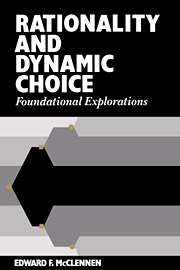Book contents
- Frontmatter
- Contents
- Conditions on orderings and acceptable-set functions
- Acknowledgments
- 1 Introduction and sketch of the main argument
- 2 The ordering principle
- 3 The independence principle
- 4 The problem of justification
- 5 Pragmatic arguments
- 6 Dynamic choice problems
- 7 Rationality conditions on dynamic choice
- 8 Consequentialist constructions
- 9 Reinterpreting dynamic consistency
- 10 A critique of the pragmatic arguments
- 11 Formalizing a pragmatic perspective
- 12 The feasibility of resolute choice
- 13 Connections
- 14 Conclusions
- 15 Postscript: projections
- Notes
- Bibliography
- Author index
- Subject index
8 - Consequentialist constructions
Published online by Cambridge University Press: 05 February 2012
- Frontmatter
- Contents
- Conditions on orderings and acceptable-set functions
- Acknowledgments
- 1 Introduction and sketch of the main argument
- 2 The ordering principle
- 3 The independence principle
- 4 The problem of justification
- 5 Pragmatic arguments
- 6 Dynamic choice problems
- 7 Rationality conditions on dynamic choice
- 8 Consequentialist constructions
- 9 Reinterpreting dynamic consistency
- 10 A critique of the pragmatic arguments
- 11 Formalizing a pragmatic perspective
- 12 The feasibility of resolute choice
- 13 Connections
- 14 Conclusions
- 15 Postscript: projections
- Notes
- Bibliography
- Author index
- Subject index
Summary
Introduction
Hammond has recently developed an approach to dynamic choice problems that closely parallels the one taken in Chapter 7. He does not explicitly appeal to the four conditions, SR, NEC, DC, and SEP. Instead, he appeals to a “consequentialist principle,” according to which acts are to be valued by their consequences. But the manner in which he glosses and applies this principle indicates that he has adopted a framework that is closely related to one defined by these four conditions.
His commitment to SR is clearly revealed in his remarks concerning the implications of his consequentialist principle for normal-form decision problems (i.e., problems requiring a single choice “up front”): “In a normal form decision problem, consequentialism means that behavior [i.e., choice of a normal-form plan] is judged to be acceptable if its consequences (or, more generally, its risky and uncertain consequences) lie in the choice set corresponding to the feasible set of consequences resulting from all possible decisions.”
Treated as a constraint on choice at the initial choice point in the tree, Hammond's consequentialist principle also implies NEC. This is clearly indicated when he remarks that “whenever two decision trees T and T′ are consequentially equivalent … then behavior in the two trees must also be consequentially equivalent. … [and] thus the structure of the decision tree must be irrelevant to the consequences of acceptable or recommended behavior.”
- Type
- Chapter
- Information
- Rationality and Dynamic ChoiceFoundational Explorations, pp. 127 - 147Publisher: Cambridge University PressPrint publication year: 1990

